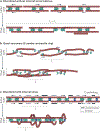Forcing cells into shape: the mechanics of actomyosin contractility
- PMID: 26130009
- PMCID: PMC7443980
- DOI: 10.1038/nrm4012
Forcing cells into shape: the mechanics of actomyosin contractility
Abstract
Actomyosin-mediated contractility is a highly conserved mechanism for generating mechanical stress in animal cells and underlies muscle contraction, cell migration, cell division and tissue morphogenesis. Whereas actomyosin-mediated contractility in striated muscle is well understood, the regulation of such contractility in non-muscle and smooth muscle cells is less certain. Our increased understanding of the mechanics of actomyosin arrays that lack sarcomeric organization has revealed novel modes of regulation and force transmission. This work also provides an example of how diverse mechanical behaviours at cellular scales can arise from common molecular components, underscoring the need for experiments and theories to bridge the molecular to cellular length scales.
Conflict of interest statement
Competing interests statement
The authors declare no competing interests.
Figures




Similar articles
-
Contractile units in disordered actomyosin bundles arise from F-actin buckling.Phys Rev Lett. 2012 Jun 8;108(23):238107. doi: 10.1103/PhysRevLett.108.238107. Epub 2012 Jun 8. Phys Rev Lett. 2012. PMID: 23003998 Free PMC article.
-
Stresses at the cell surface during animal cell morphogenesis.Curr Biol. 2014 May 19;24(10):R484-94. doi: 10.1016/j.cub.2014.03.059. Curr Biol. 2014. PMID: 24845681 Review.
-
'Sarcomeres' of smooth muscle: functional characteristics and ultrastructural evidence.J Cell Sci. 2005 Jun 1;118(Pt 11):2381-92. doi: 10.1242/jcs.02368. J Cell Sci. 2005. PMID: 15923651
-
Actomyosin contractility and RhoGTPases affect cell-polarity and directional migration during haptotaxis.Integr Biol (Camb). 2016 Oct 10;8(10):1067-1078. doi: 10.1039/c6ib00152a. Integr Biol (Camb). 2016. PMID: 27713970
-
Pli Selon Pli: Mechanochemical Feedback and the Morphogenetic Role of Contractility at Cadherin Cell-Cell Junctions.Curr Top Dev Biol. 2016;117:631-46. doi: 10.1016/bs.ctdb.2015.10.021. Epub 2016 Jan 7. Curr Top Dev Biol. 2016. PMID: 26970005 Review.
Cited by
-
Boundaries steer the contraction of active gels.Nat Commun. 2016 Oct 14;7:13120. doi: 10.1038/ncomms13120. Nat Commun. 2016. PMID: 27739426 Free PMC article.
-
Ebola Virus Nucleocapsid-Like Structures Utilize Arp2/3 Signaling for Intracellular Long-Distance Transport.Cells. 2020 Jul 19;9(7):1728. doi: 10.3390/cells9071728. Cells. 2020. PMID: 32707734 Free PMC article.
-
Actin contraction controls nuclear blebbing and rupture independent of actin confinement.Mol Biol Cell. 2024 Feb 1;35(2):ar19. doi: 10.1091/mbc.E23-07-0292. Epub 2023 Dec 13. Mol Biol Cell. 2024. PMID: 38088876 Free PMC article.
-
MEDYAN: Mechanochemical Simulations of Contraction and Polarity Alignment in Actomyosin Networks.PLoS Comput Biol. 2016 Apr 27;12(4):e1004877. doi: 10.1371/journal.pcbi.1004877. eCollection 2016 Apr. PLoS Comput Biol. 2016. PMID: 27120189 Free PMC article.
-
Cortical softening elicits zygotic contractility during mouse preimplantation development.PLoS Biol. 2022 Mar 24;20(3):e3001593. doi: 10.1371/journal.pbio.3001593. eCollection 2022 Mar. PLoS Biol. 2022. PMID: 35324889 Free PMC article.
References
-
- Munjal A & Lecuit T Actomyosin networks and tissue morphogenesis. Development 141, 1789–1793 (2014). - PubMed
-
- Salbreux G, Charras G & Paluch E Actin cortex mechanics and cellular morphogenesis. Trends Cell Biol 10, 536–545 (2012). - PubMed
-
- Green RA, Paluch E & Oegema K Cytokinesis in animal cells. Annu. Rev. Cell Dev. Biol 28, 29–58 (2012). - PubMed
Publication types
MeSH terms
Substances
Grants and funding
LinkOut - more resources
Full Text Sources
Other Literature Sources

